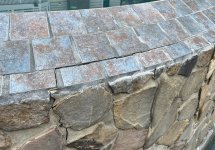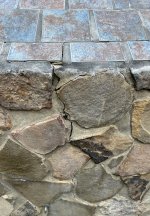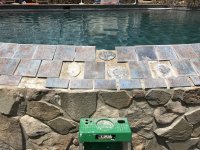I had a pool party yesterday and had the pool running all afternoon and evening. At the end of the party, I noticed a large crack along several of the tiles at the bottom of my vanishing edge tiles and extends down the face stone. This appeared relatively suddenly. There was no evidence of leaking or other issues in this area before the crack appeared. I regrouted this tile 2 years ago and it doesn’t seem to be leaking. The area is dry if I let the pool level drop about a half inch so no water flows over the edge. I also don’t see any significant efflorescence below this area indicating a leak. Thoughts on what happened? How do I confirm this is only cosmetic?
My thoughts are there is a small leak at the peak of the tiles that lets in water when the full edge effect is running. This water builds up behind the grouted tile until it gave way. I don’t know how to look for a leak since it only happens when the water is flowing rapidly over the edge so dye testing is not feasible.
When I regrouted 2 years ago, I checked all the tiles and they were solidly attached the wall. They are obviously loose now.
Thoughts?
My thoughts are there is a small leak at the peak of the tiles that lets in water when the full edge effect is running. This water builds up behind the grouted tile until it gave way. I don’t know how to look for a leak since it only happens when the water is flowing rapidly over the edge so dye testing is not feasible.
When I regrouted 2 years ago, I checked all the tiles and they were solidly attached the wall. They are obviously loose now.
Thoughts?





